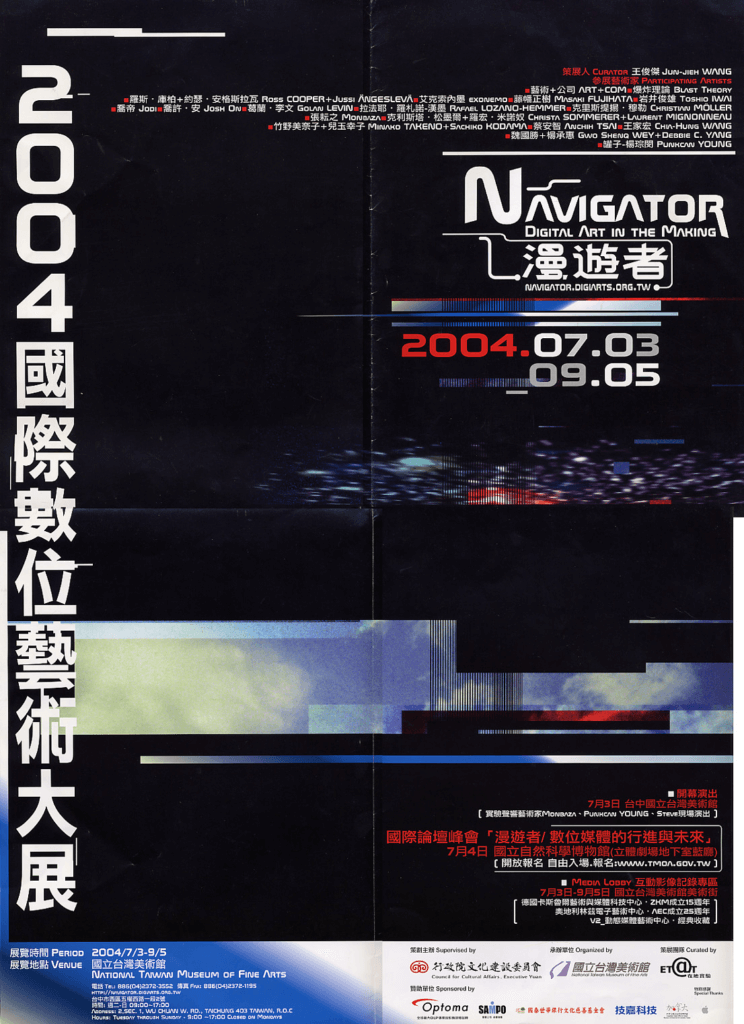National Taiwan Museum of Fine Arts, 國立臺灣美術館, Taichung, Taiwan
2004年7月3日至9月5日
作品名稱:空間魂魄 Space sprite
Behavior of inorganic being in extensity (2004)
Digital sound artwork, Behavior of Inorganic being in Extensity, is a question the artist proposes to the “form of soul.” Is “form of soul” a pure entity? Or is it an assemblage of inorganic status? Is there a “soul” in an incident? Is there a soul in an idea? Is there a soul within breathe in and breathe out? Has space a soul?
The artist makes soul an analogy to our sense of sight, and it presents the differences between tone and the infinite series of tone. We can distinguish a voice as “voice” right at the moment we hear it in a space, just like what we know about “a soul.” Nevertheless, is it truly the entity of voice and soul? Sounds you heard in a space, when recognized by your brain, had contained structures of many entities that gave off sounds—the variance of air vibration, the diminishing effect caused by range and mediums during delivery, density and temperature, and even the structural variation of your brain—how your brain interprets sensibility, and how your body quakes by itself. The “sound,” as we regard it to be, is structured by countless interweaving of phenomena. If getting rid of the structure framed by current space and time, in the micro blink of time, is sound existing outside the momentary fragmental mode? Or is the structure of sound constructed inside your memory or your sensibility? Perhaps it is the influence of time that realizes sounds within infinite moments, in that sense, the sound recognized by our sensibility is the assemblage structured with the axis of time. Behavior of Inorganic being in Extensity intends to present a micro sense toward our environment, just like that of the continuous slow breathing of humans.
《空間魂魄》(2004)
數位聲響作品《空間魂魄》是創作者對「靈魂型態」的發問。「靈魂型態」到底是一個純然的個體?還是一種離散狀態的集合? 一個發生的事件是否有靈魂?一個念頭是否有靈魂?一呼一吸是否有靈魂?一個空間是否有靈魂?
擺脫掉現有空間跟時間的架構,時間的極微點,對於聲音是存在瞬間片段的模式以外,聲音架構在你的記憶裡還是感官中?也許是因為時間的影響才將無限的瞬間理解成聲音,如此一來,感官理解所謂的聲音就成了以時間為主軸所構成的集合。 《空間魂魄》欲呈現的是一種對環境的微觀感受,就如同人們的緩慢呼吸的連續。
基於「咒術」的探討,我嘗試利用聲音為媒介,探索咒術中一個理論:如果萬物皆有魂魄,空間本身是否具備魂魄。
真正引起我討論這問題的契機,是幾次到語言不通的環境時,環境中有種不可理解的力量緩緩地影響著個人的行為跟認知能力,這個過程幫助我很快的融入語言不通的環境中。
甚至恍惚之間,有屬於空間的其他記憶也被讀取進來了。
重現空間本身的魂魄是一個「不可証」的問題,於是我轉換另一個形式,採用「觀想」的概念來進行。
「觀想」在咒術領域是一種非常原始的概念,是利用替代品驅動或是誘導認知系統的一種做法,人們對於空間的認知更偏向「邊界」的概念,對於邊界內部本身的空間,則更偏向抽象的狀態,但是對於盲人來說,聲音對於內部空間的體現卻是非常具象的。
展覽現場是一個5m*5m*5m的封閉空間,利用四個音箱建構出在空間產生共鳴的音牆,並透過頻率跟相位的變化,移動共鳴點或是抵銷掉局部的聲音,讓聲音在一個封閉空間形成一個動態且不平均的密度,在黑暗的空間中重新理解空間的型態。
原始作品為四個音軌,因為年代久遠已經找不到當時的多軌道版本。
